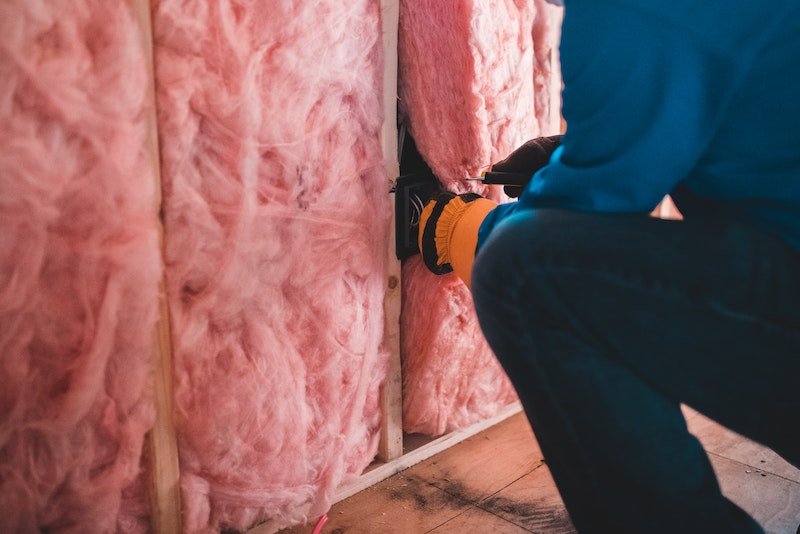Wet Insulation: Is It A Risk? What to Do About It

Insulation, when installed properly, is a fantastic luxury that keeps us warm in the winter and cool in the summer. However, if that insulation gets wet, it could be a different story. Is wet insulation a risk and if so, what can be done about it?
Wet insulation can become a health risk. If insulation is left wet for long enough, mold and bacteria will start to grow in it. This severely decreases air quality and can lead to major health risks. The longer wet insulation is left alone, the more bacteria grows and the greater the risk to your health and home becomes.
Wet Insulation: The Risks
Wet insulation is usually found in the roof where leaks and water exposure is more likely and possible to occur. Replacing insulation can be an expensive, time-consuming, and labor-intensive process, but it is also an issue that cannot be ignored. The moment you suspect your insulation is wet, you should check it out.
Higher Energy Bills
Believe it or not, wet insulation might actually cause your energy bills to go up. Insulation is supposed to repel electricity, not conduct it, but that’s exactly what will happen if the insulation gets wet. Wet insulation also becomes less efficient at its job, so it will take twice as much heat in the winter and twice as much air conditioning in the summer to keep your home at a comfortable temperature. If your electrical bills have suddenly gone through the roof, you may want to check your insulation.
Air Quality
One of the more commonly known issues with wet insulation is that it is an air quality reducer. If mold and bacteria start to grow on your insulation, spores and particles that are detrimental to your health will start escaping into the air. If you have wet, moldy insulation, you may start to experience things like eye irritation, respiratory irritation, pulmonary effects, and possibly even things as severe as pneumonia—yet another reason why you should not leave the problem unattended.
Off-Gassing Chemicals
Insulation made with minerals, fiberglass, or wool often contains a chemical called formaldehyde, which becomes another liability if the insulation gets wet. When formaldehyde is wet or starts to experience a lot of humidity, it starts off-gassing. This is not only extremely detrimental to your health, but it will also start to corrode your roof structures from the inside out, including rusting studs and bolts. The levels of gas will decrease in time, but it won’t ever go away on its own unless fixed.
Odors and Smells
If you have wet insulation inside your wall cavity, you might start to notice it giving off an odor. You might not necessarily know where it’s coming from, but you will definitely notice it there. If the wetness is left unattended for long enough, you might even start to see dark mold spots growing on your wall, or ceiling, or both. If possible, you should try to get it checked out by a professional once you start noting a mildewy smell. You will definitely know something is wrong the moment mold starts growing on the wall.
Roof Leaks Lead to All Kinds of Issues
Water that has accessed your insulation will likely have accessed beams and rafters, causing mold and rot on your wood. That, too, will compromise your safety. If the rotting spreads, you may end up having to replace more than just the insulation, so get on it as soon as possible!
Causes/Fixes of Wet Insulation
Now you know why wet insulation is bad, so next, you need to learn how to fix it. Here are a few common culprits that might be getting your insulation wet:
Air Gaps and Condensation
One of the most common causes of wet insulation in a wall cavity is air gaps and condensation. When cold air gets trapped inside a wall, the warm air will cause it to condensate, thus getting the insulation wet. Cold air usually gets in through siding or window and door framing/casing. If there are too many air gaps, this problem will grow steadily worse, so definitely check for those if your mission is to minimize condensation, and if you find any, make sure to seal up those gaps.
Overhead Drips
Overhead drips are also a common problem, and these can affect wall insulation as well as attic insulation. If your attic is not properly vented, moisture and condensation will form and drip onto the insulation (lack of air circulation). This can seep all the way down through the walls, sometimes soaking the drywall (you will be able to tell if this happens). Fortunately, overhead drips are also a tad easier to identify because they leave telltale signs (like puddles forming on the floor of your attic). You should take immediate action if you notice this occurring. Try to install proper ventilation to promote better air circulation.
At Koala Insulation of Gateway West, our team is dedicated to increasing comfort and safety for you and your household. This includes ensuring our service not only brings you cost-effective and energy-efficient installations but also materials that have been treated and tested to improve the security of your home. If you have questions or concerns about the material currently in your home, our industry experts can provide details on your current condition and how your safety and comfort can improve.
Find Your Location


Get a quote


